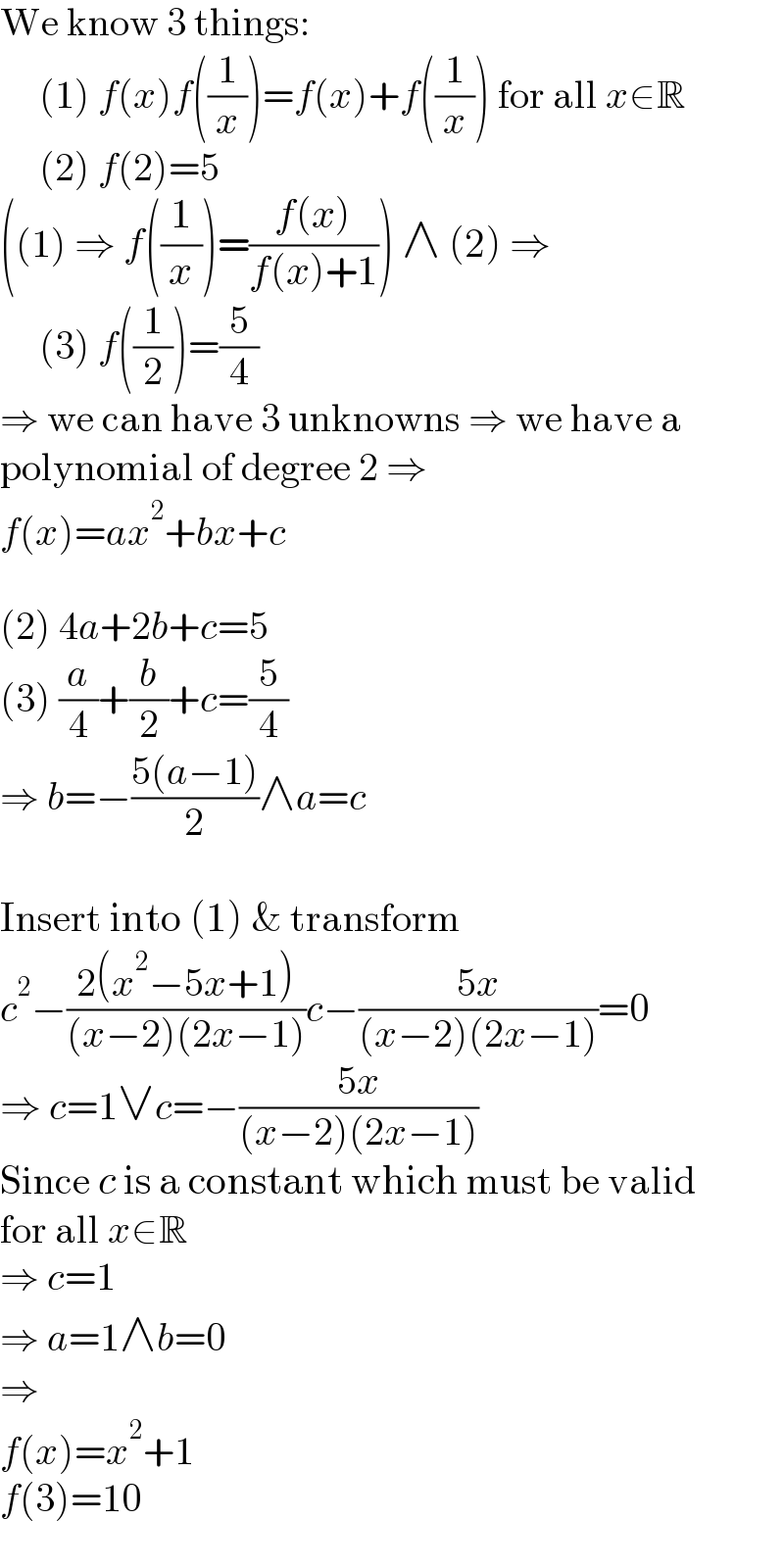
Question Number 211029 by BaliramKumar last updated on 26/Aug/24

Answered by Ar Brandon last updated on 26/Aug/24

$${f}\left(\mathrm{2}\right)=\mathrm{5}\:\mathrm{therefore}\:{f}\left({x}\right)\:\mathrm{must}\:\mathrm{be}\:\mathrm{a}\:\mathrm{non}-\mathrm{zero}\:\mathrm{polynomial}. \\ $$$$\mathrm{Let}\:{f}\left({x}\right)={a}_{\mathrm{0}} +{a}_{\mathrm{1}} {x}+{a}_{\mathrm{2}} {x}^{\mathrm{2}} +\centerdot\centerdot\centerdot+{a}_{{n}} {x}^{{n}} ,\:{a}_{{n}} \neq\mathrm{0} \\ $$$$\mathrm{Suppose}\:{f}\left({x}\right)+{f}\left(\frac{\mathrm{1}}{{x}}\right)={f}\left({x}\right){f}\left(\frac{\mathrm{1}}{{x}}\right)\:\mathrm{for}\:\mathrm{all}\:{x}\neq\mathrm{0} \\ $$$$\mathrm{Then}\:\underset{\mathrm{r}=\mathrm{0}} {\overset{{n}} {\sum}}{a}_{\mathrm{r}} {x}^{\mathrm{r}} +\underset{\mathrm{r}=\mathrm{1}} {\overset{{n}} {\sum}}\frac{{a}_{\mathrm{r}} }{{x}^{\mathrm{r}} }=\left(\underset{\mathrm{r}=\mathrm{0}} {\overset{{n}} {\sum}}{a}_{\mathrm{r}} {x}^{\mathrm{r}} \right)\left(\underset{\mathrm{r}=\mathrm{1}} {\overset{{n}} {\sum}}\frac{{a}_{\mathrm{r}} }{{x}^{\mathrm{r}} }\right) \\ $$$$\mathrm{Multiplying}\:\mathrm{through}\:\mathrm{by}\:{x}^{{n}} , \\ $$$$\underset{\mathrm{r}=\mathrm{0}} {\overset{{n}} {\sum}}{a}_{\mathrm{r}} {x}^{{n}+\mathrm{r}} +\underset{\mathrm{r}=\mathrm{0}} {\overset{{n}} {\sum}}{a}_{\mathrm{r}} {x}^{{n}−\mathrm{r}} =\left(\underset{\mathrm{r}=\mathrm{0}} {\overset{{n}} {\sum}}{a}_{\mathrm{r}} {x}^{\mathrm{r}} \right)\left(\underset{\mathrm{r}=\mathrm{0}} {\overset{{n}} {\sum}}{a}_{\mathrm{r}} {x}^{{n}−\mathrm{r}} \right) \\ $$$$\mathrm{That}\:\mathrm{is}, \\ $$$$\left({a}_{\mathrm{0}} {x}^{{n}} +{a}_{\mathrm{1}} {x}^{{n}+\mathrm{1}} +\centerdot\centerdot\centerdot{a}_{{n}} {x}^{\mathrm{2}{n}} \right)+\left({a}_{\mathrm{0}} {x}^{{n}} +{a}_{\mathrm{1}} {x}^{{n}−\mathrm{1}} +\centerdot\centerdot\centerdot+{a}_{{n}−\mathrm{1}} {x}+{a}_{{n}} \right) \\ $$$$\:\:\:\:\:\:=\left({a}_{\mathrm{0}} +{a}_{\mathrm{1}} {x}+\centerdot\centerdot\centerdot{a}_{{n}} {x}^{{n}} \right)\left({a}_{\mathrm{0}} {x}^{{n}} +{a}_{\mathrm{1}} {x}^{{n}−\mathrm{1}} +\centerdot\centerdot\centerdot+{a}_{{n}−\mathrm{1}} {x}+{a}_{{n}} \right) \\ $$$$\mathrm{Equating}\:\mathrm{the}\:\mathrm{corresponding}\:\mathrm{coefficients}\:\mathrm{of}\:\mathrm{powers}\:\mathrm{of}\:{x}, \\ $$$$\mathrm{we}\:\mathrm{have} \\ $$$$\:\:\:\:\:\:\:\:\:{a}_{{n}} ={a}_{\mathrm{0}} {a}_{{n}} ,\:{a}_{{n}−\mathrm{1}} ={a}_{\mathrm{0}} {a}_{{n}−\mathrm{1}} +{a}_{\mathrm{1}} {a}_{{n}} \\ $$$$\:\:\:\:\:\:\:\:\:{a}_{{n}−\mathrm{2}} ={a}_{\mathrm{2}} {a}_{{n}} +{a}_{\mathrm{1}} {a}_{{n}−\mathrm{1}} +{a}_{{n}−\mathrm{2}} {a}_{\mathrm{0}} \\ $$$$\:\:\:\:\:\:\:\:\:\mathrm{2}{a}_{\mathrm{0}} ={a}_{\mathrm{0}} ^{\mathrm{2}} +{a}_{{n}} ^{\mathrm{2}} \\ $$$$\:\:\:\:\:\:\:\:\:\:{a}_{{n}} ={a}_{\mathrm{0}} {a}_{{n}} \Rightarrow{a}_{\mathrm{0}} =\mathrm{1}\:\left(\mathrm{since}\:{a}_{{n}} \neq\mathrm{0}\right) \\ $$$$\:\:\:\:\:\:\:\:\:\:{a}_{{n}−\mathrm{1}} ={a}_{\mathrm{0}} {a}_{{n}−\mathrm{1}} +{a}_{\mathrm{1}} {a}_{{n}} \Rightarrow{a}_{\mathrm{1}} {a}_{{n}} =\mathrm{0}\Rightarrow{a}_{\mathrm{1}} =\mathrm{0} \\ $$$$\:\:\:\:\:\:\:\:\:\:{a}_{{n}−\mathrm{2}} ={a}_{\mathrm{2}} {a}_{{n}} +{a}_{\mathrm{1}} {a}_{{n}−\mathrm{1}} +{a}_{{n}−\mathrm{2}} {a}_{\mathrm{0}} \Rightarrow{a}_{{n}−\mathrm{2}} ={a}_{\mathrm{2}} {a}_{{n}} +{a}_{{n}−\mathrm{2}} \Rightarrow{a}_{\mathrm{2}} =\mathrm{0} \\ $$$$\mathrm{Continuing}\:\mathrm{this}\:\mathrm{process},\:\mathrm{we}\:\mathrm{get}\:{a}_{{n}−\mathrm{1}} =\mathrm{0}\:\mathrm{and}\:\mathrm{2}=\mathrm{1}+{a}_{{n}} ^{\mathrm{2}} . \\ $$$$\mathrm{Hence}\:{a}_{{n}} =\pm\mathrm{1}.\:\mathrm{Therefore} \\ $$$$\:\:\:\:\:\:\:\:\:\:\:\:\:\:\:\:\:\:\:\:\:\:\:\:\:\:\:\:\:\:\:\:\:\:\:\:\:\:\:\:\:\:\:\:\:\:\:\:{f}\left({x}\right)=\mathrm{1}\pm{x}^{{n}} \\ $$$$\mathrm{But}\:{f}\left(\mathrm{2}\right)=\mathrm{5}\:\mathrm{hence} \\ $$$$\:\:\:\:\:\:\:\:\:\:\:\:\:\:\:\:\:\:\:\:\:\:\:\:\:\:\:\:\:\:\:\:\:\:\mathrm{5}=\mathrm{1}\pm\mathrm{2}^{\mathrm{n}} \\ $$$$\mathrm{Therefore}\:{f}\left({x}\right)\:\mathrm{cannot}\:\mathrm{be}\:\mathrm{1}−{x}^{{n}} .\:\mathrm{Thus},\:{f}\left({x}\right)=\mathrm{1}+{x}^{{n}} \:\mathrm{and} \\ $$$$\mathrm{5}=\mathrm{1}+\mathrm{2}^{{n}} \:\Rightarrow\:{n}=\mathrm{2}.\:\mathrm{So}\:{f}\left({x}\right)=\mathrm{1}+{x}^{\mathrm{2}} \:\mathrm{and}\:\begin{array}{|c|}{{f}\left(\mathrm{3}\right)=\mathrm{10}}\\\hline\end{array}. \\ $$
Commented by Frix last updated on 26/Aug/24
��
Commented by Ar Brandon last updated on 26/Aug/24
Greetings, Sir! it's been quite a long time��
Commented by BaliramKumar last updated on 27/Aug/24

$${Thanks}\:{sir} \\ $$
Commented by Ar Brandon last updated on 27/Aug/24
You're welcome!
Answered by Frix last updated on 26/Aug/24

$$\mathrm{We}\:\mathrm{know}\:\mathrm{3}\:\mathrm{things}: \\ $$$$\:\:\:\:\:\left(\mathrm{1}\right)\:{f}\left({x}\right){f}\left(\frac{\mathrm{1}}{{x}}\right)={f}\left({x}\right)+{f}\left(\frac{\mathrm{1}}{{x}}\right)\:\mathrm{for}\:\mathrm{all}\:{x}\in\mathbb{R} \\ $$$$\:\:\:\:\:\left(\mathrm{2}\right)\:{f}\left(\mathrm{2}\right)=\mathrm{5} \\ $$$$\left(\left(\mathrm{1}\right)\:\Rightarrow\:{f}\left(\frac{\mathrm{1}}{{x}}\right)=\frac{{f}\left({x}\right)}{{f}\left({x}\right)+\mathrm{1}}\right)\:\wedge\:\left(\mathrm{2}\right)\:\Rightarrow \\ $$$$\:\:\:\:\:\left(\mathrm{3}\right)\:{f}\left(\frac{\mathrm{1}}{\mathrm{2}}\right)=\frac{\mathrm{5}}{\mathrm{4}} \\ $$$$\Rightarrow\:\mathrm{we}\:\mathrm{can}\:\mathrm{have}\:\mathrm{3}\:\mathrm{unknowns}\:\Rightarrow\:\mathrm{we}\:\mathrm{have}\:\mathrm{a} \\ $$$$\mathrm{polynomial}\:\mathrm{of}\:\mathrm{degree}\:\mathrm{2}\:\Rightarrow \\ $$$${f}\left({x}\right)={ax}^{\mathrm{2}} +{bx}+{c} \\ $$$$ \\ $$$$\left(\mathrm{2}\right)\:\mathrm{4}{a}+\mathrm{2}{b}+{c}=\mathrm{5} \\ $$$$\left(\mathrm{3}\right)\:\frac{{a}}{\mathrm{4}}+\frac{{b}}{\mathrm{2}}+{c}=\frac{\mathrm{5}}{\mathrm{4}} \\ $$$$\Rightarrow\:{b}=−\frac{\mathrm{5}\left({a}−\mathrm{1}\right)}{\mathrm{2}}\wedge{a}={c} \\ $$$$ \\ $$$$\mathrm{Insert}\:\mathrm{into}\:\left(\mathrm{1}\right)\:\&\:\mathrm{transform} \\ $$$${c}^{\mathrm{2}} −\frac{\mathrm{2}\left({x}^{\mathrm{2}} −\mathrm{5}{x}+\mathrm{1}\right)}{\left({x}−\mathrm{2}\right)\left(\mathrm{2}{x}−\mathrm{1}\right)}{c}−\frac{\mathrm{5}{x}}{\left({x}−\mathrm{2}\right)\left(\mathrm{2}{x}−\mathrm{1}\right)}=\mathrm{0} \\ $$$$\Rightarrow\:{c}=\mathrm{1}\vee{c}=−\frac{\mathrm{5}{x}}{\left({x}−\mathrm{2}\right)\left(\mathrm{2}{x}−\mathrm{1}\right)} \\ $$$$\mathrm{Since}\:{c}\:\mathrm{is}\:\mathrm{a}\:\mathrm{constant}\:\mathrm{which}\:\mathrm{must}\:\mathrm{be}\:\mathrm{valid} \\ $$$$\mathrm{for}\:\mathrm{all}\:{x}\in\mathbb{R} \\ $$$$\Rightarrow\:{c}=\mathrm{1} \\ $$$$\Rightarrow\:{a}=\mathrm{1}\wedge{b}=\mathrm{0} \\ $$$$\Rightarrow \\ $$$${f}\left({x}\right)={x}^{\mathrm{2}} +\mathrm{1} \\ $$$${f}\left(\mathrm{3}\right)=\mathrm{10} \\ $$
Commented by BaliramKumar last updated on 27/Aug/24

$${Thanks}\:{sir} \\ $$
